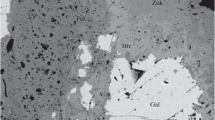Abstract
In the oxidation zone of the Berezovskoe gold deposit in the middle Urals, Russia, minerals of the beudantite–segnitite series (idealized formulas PbFe3 3+ AsO4)(SO4)(OH)6 and PbFe3 3+ AsO4)(AsO3OH)(OH)6, respectively) form a multicomponent solid solution system with wide variations in the As, S, Fe, Cu, and Sb contents and less variable P, Cr, Zn, Pb, and contents K. The found minerals of this system correspond to series from beudantite with 1.25 S apfu to S-free segnitite, with segnitite lacking between 1.57 and 1.79 As apfu. Segnitite at the Berezovskoe deposit contains presumably pentavalent Sb (up to 15.2 wt % Sb2O5 = 0.76 Sb apfu, the highest Sb content in the alunite supergroup minerals), which replaces Fe3+. The Sb content increases with increasing As/S value. On the contrary, beudantite is free of or very poor in Sb (0.00–0.03 Sb apfu). Many samples of segnitite are enriched in Cu (up to 8.2 wt% CuO = 0.83 Cu apfu, uncommonly high Cu content for this mineral) and/or in Zn (up to 2.0 wt% ZnO = 0.19 Zn apfu). Both Cu and Zn replace Fe. The generalized formula of a hypothetic end member of the segnitite series with 1 Sb apfu is Pb(Fe3+ M 2+Sb5+)(AsO4)2(OH)6, where M = Cu, Zn, Fe2+. The chemical evolution of beudantite–segnitite series minerals at the Berezovskoe deposit is characterized by an increase in the S/As value with a decrease in the Sb content from early to late generations.
Similar content being viewed by others
References
Arzruni, A.E., Mineralvorkommen von Berjosowsk, Zeit. Krist, 1888, vol. 33, pp. 90–92.
Bayliss, P., Kolitsch, U., Nickel, E.H., and Pring, A., Alunite supergroup: recommended nomenclature, Mineral. Mag., 2010, vol. 74, no. 5, pp. 919–927.
Bushmakin, A.F. and Kotlyarov, V.A., Beudantite from the Berezovskoe deposit at Middle Urals, Uralsk. Mineral. Sb., 1995, no. 5, pp. 145–148.
Chukanov, N.V., Infrared Spectra of Mineral Species: Extended Library, Dordrecht–Heidelberg–New York—London: Springer-Verlag, 2014.
Filimonov, S.V., Fahlerz-group minerals as indicators of ore genesis (on the example of hydrothermal gold deposits), Extended Abstract of Cand. Sci. (Geol.-Min.) PhD thesis, Moscow: Moscow State University, 2009.
Kleymenov, D.A., Albrekht, V.G., Erokhin, Y.V., Batalin, A.S., and Batalina, A.A., Berezovskoe zolotorudnoe mestorozhdenie (istoriya i mineralogiya) (The Berezovskoe Gold Deposit (History and Mineralogy)), Yekaterinburg: Uralskiy Rabochiy, 2005, p. 200.
Kolitsch, U., Slade, P.G., Tiekink, E.R.T., and Pring, A., The structure of antimonian dussertite and the role of antimony in oxysalt minerals, Mineral. Mag., 1999, vol. 63, pp. 17–26.
Mills, S.J., The crystal chemistry and geochronology of minerals from Broken Hill, Ph. D. Thesis, University of Melbourne: School of Earth Sciences, 2007.
Mills, S.J., Etschmann, B., Kampf, A.R., Poirier, G., and Newville, M., Sb5+ and Sb3+ substitution in segnitite: a new sink for As and Sb in the environment and implications for acid mine drainage, Am. Mineral., 2014, vol. 99, pp. 1355–1359.
Pekov, I.V., Zubkova, N.V., Gottlicher, J., Yapaskurt, V.O., Chukanov, N.V., Lykova, I.S., Belakovskiy, D.I., Jensen, M.C., Leising, J.F., Nikischer, A.J., and Pushcharovsky, D.Yu., Whitecapsite, a new hydrous iron and trivalent antimony arsenate mineral from the White Caps mine, Nevada, USA. Eur. J. Mineral., 2014, vol. 26, pp. 577–587.
Shannon, R.D., Revised effective ionic radii and systematic studies of interatomic distances in halides and chalcogenides. Acta Cryst., 1976, A32, pp. 751–767.
Smith, D.K., Roberts, A.C., Bayliss, P., and Liebau, F., A systematic approach to general and structure-type formulas for minerals and other inorganic phases, Am. Mineral., 1998, vol. 83, pp. 126–132.
Author information
Authors and Affiliations
Corresponding author
Additional information
Original Russian Text © I.V. Pekov, D.A. Khanin, V.O. Yapaskurt, A.V. Pakunova, I.A. Ekimenkova, 2015, published in Zapiski Rossiiskogo Mineralogicheskogo Obshchestva, 2015, No. 3, pp. 89–105.
Rights and permissions
About this article
Cite this article
Pekov, I.V., Khanin, D.A., Yapaskurt, V.O. et al. Minerals of the beudantite–segnitite series from the oxidation zone of the Berezovskoe gold deposit, middle Urals: Chemical variations, behavior of admixtures, and antimonian varieties. Geol. Ore Deposits 58, 600–611 (2016). https://doi.org/10.1134/S1075701516070096
Received:
Published:
Issue Date:
DOI: https://doi.org/10.1134/S1075701516070096




